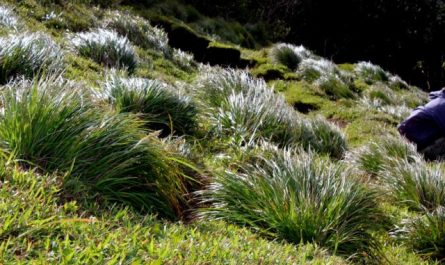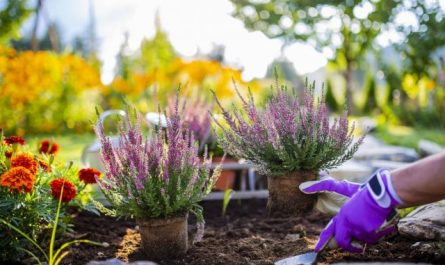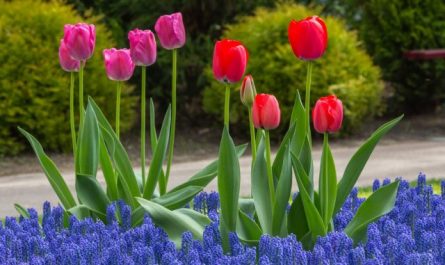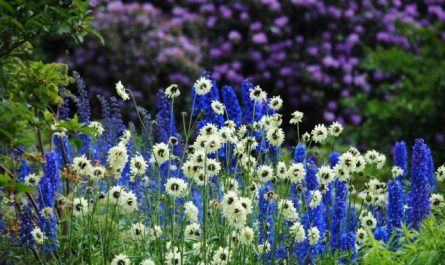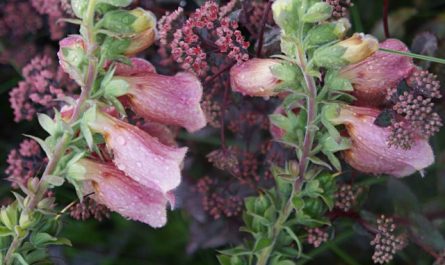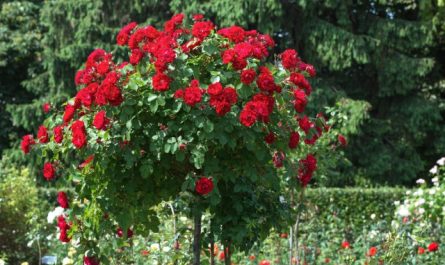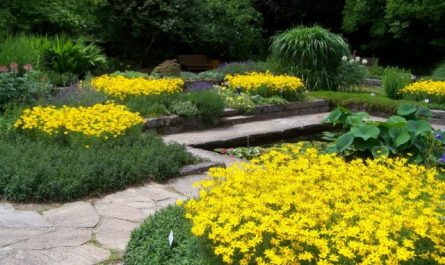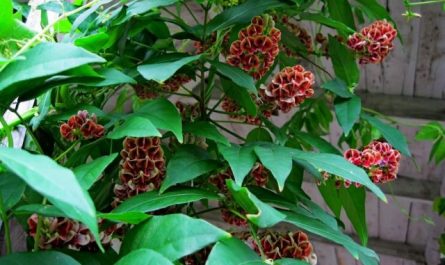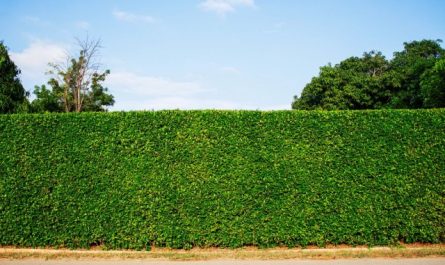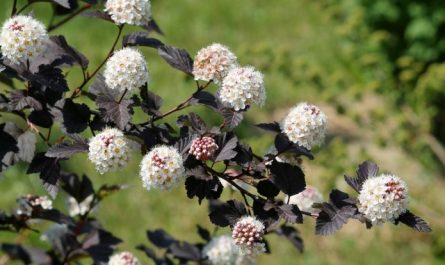The genus of rhododendrons is large and diverse. It includes evergreen, semi-evergreen and deciduous shrubs, dwarf shrubs, and sometimes trees. Translated from Greek, rhododendron means “rose tree”. But the rhododendron from the heather family has nothing to do with the rose from the Rosaceae family. They are connected only by the beauty of flowering and a huge variety of species and varieties.

Description of rhododendron
Rhododendron (Rhododendron) is a genus of plants in the Heather family. A large genus that includes about eight hundred species of evergreen, semi-deciduous and deciduous shrubs and trees.
The genus Rhododendron includes azaleas, widely known in indoor and greenhouse floriculture, which some taxonomists classify as a subgenus or section of the genus.
Rhododendrons are found mainly in the temperate zone of the Northern Hemisphere, with the greatest diversity of species being found in Southern China, the Himalayas, Japan, Southeast Asia, and North America. They are also found in the Southern Hemisphere, in New Guinea and northeastern Australia. Plants vary greatly in size: some species reach a height of 30 m, but there are also creeping shrubs. Flowers range in size from tiny to over 20 cm in diameter.
In Russia, up to 18 species are found in natural conditions, mainly in the Caucasus (for example, Yellow Rhododendron), Siberia and the Far East.

Choosing a Place to Plant Rhododendron
A very important point is the correct choice of the place for planting the rhododendron bush. Rhododendrons dictate their conditions, and they are capricious in the choice of lighting, soil and neighbors – it is not always easy to fit a new bush into an already formed plant community.
The place for planting rhododendrons should be protected from prevailing winds and direct sunlight, without stagnant water and with an acidic soil reaction.
All rhododendrons need sun, but to varying degrees. Highland dwarf rhododendrons are especially sun-loving. Most large-flowered evergreens prefer to grow in partial shade. Some tolerate periodic shading, but rhododendrons cannot stand constant shade – then they do not bloom at all or bloom very weakly. Pines are considered ideal neighbors for them – there is enough light under them, and the deep root system does not interfere with the flowering bush.
By the way, this is another mandatory condition when planting rhododendrons – that there are no large trees with a shallow root system near the planting hole. Such as maples, lindens, alders, willows and especially birches – their roots dry out and deplete the soil, and it is difficult for rhododendrons to compete with them. To protect the rhododendron from the underground aggression of large neighbors, the planting hole can be insulated from below and from the sides with a solid piece of dense non-woven covering material.
Many years of experience show that these plants feel good near water bodies, where the air is humid. Therefore, they are planted near ponds and lakes, streams and pools. If there is no water nearby, evergreen rhododendrons are sprayed once a week before flowering. But it is not advisable to pour water on flowering plants; it is better to water the bushes more often.

Features of planting rhododendron
The best time to plant rhododendrons is spring. When planted in spring, the plants have the opportunity to adapt well and take root in a new place. And you will have the opportunity to admire the first flowering. Plants with a closed root system (in a container) can be planted at a later date.
Planting holes are prepared in advance at the selected location. The root system of rhododendrons is quite compact, so even for tall species it is enough to dig a hole about 50 cm deep and 70-80 cm wide. The distance between plants depends on the height and diameter of the crown of the bush and is on average from 0,7 to 2 m. Drainage at the bottom of the hole is required: a layer of broken brick and sand 15-20 cm, if the planting hole is deep, then the drainage layer increases to 30-40 cm and includes fine gravel or crushed stone (but not limestone!).
It should be remembered that in nature rhododendrons grow on acidic, humus-rich, loose, air- and water-permeable soils. Therefore, the garden substrate should be appropriate: a mixture of leaf soil, high-moor peat, coniferous litter (3:2:1) with the addition of complete mineral fertilizer: 70 g per hole. Optimum soil acidity is 4,5-5,0.
Before planting, the rhododendron root ball taken out of the pot should be well soaked in water. If it has dried out, it is immersed in water and wait until air bubbles stop being released. The bush is planted in a hole filled with substrate, making sure that the root collar is not buried, but is 2-4 cm higher than the soil level, taking into account its subsidence. A trunk hole with raised edges is made around the bush and it is watered abundantly.
Rhododendrons have a shallow, sensitive root system (30-40 cm), which develops mainly in the litter and humus horizon. Therefore, mulching material is necessarily poured around the planted bushes, which retains moisture, prevents overheating of the soil and the growth of weeds, protects the roots from mechanical damage, and reduces the depth of soil freezing. Pine bark or chips, coniferous litter, peat are best suited as mulch, while the mulch layer should be at least 5 cm.

Care of rhododendrons
Correctly planted rhododendrons take root well. If the soil substrate was made qualitatively, they will not require special care.
During hot and dry summer and even autumn months, it is necessary to ensure that the soil under the bushes does not dry out. However, do not get carried away – excessive watering is harmful to them.
Since these plants live in high humidity conditions in the mountains, they usually respond very well to spraying the entire bush with leaves and flowers. Naturally, this should not be done under the scorching sun or with icy water.
It is best to water with rain or river water. Water from an artesian well or a water supply contains a lot of calcium and magnesium salts – the soil in this case will begin to alkalize and saline, and the rhododendrons will lose their decorative properties. (At first, nothing seems to happen, but after 2-4 years, hard water will do its job.)
To prevent the soil substrate from becoming alkaline, the water for irrigation must be acidified – best with sulfuric acid. It is difficult to specify the exact concentration of acid – it depends on the degree of water hardness. The easiest way is to use litmus paper. The hydrogen index (pH) of the water should be 3,5–4,5.
Faded inflorescences that reduce the decorative value of the plant should be broken off or carefully trimmed, preserving the axillary buds of the upper leaves. This promotes abundant growth and flowering of rhododendrons next year.
Wintering of rhododendrons
Wintering is the most important stage in the life of rhododendrons. The flowering of the next year depends on it.
As a rule, deciduous species overwinter better in the middle zone than evergreen ones. Deciduous rhododendrons such as Daurian, Japanese, yellow, Canadian, Ledebour, Schlippenbach do not need to be covered – just in case, cover only the root collar area with dry leaves or peat.
The situation is more complicated with evergreen rhododendrons. Even winter-hardy ones (Caucasian, Katevbinsky) are best grown with shelter. In winter, they do not freeze as much as dry out – they need protection from wind and sun. Houses knocked together from boards and covered with roofing felt are good for this purpose.
Such shelter will not protect less winter-hardy evergreen rhododendrons. They will need houses covered with porous insulating material (polypropylene foam, polyurethane foam, etc.). Fragile insulation (foam plastic) is unsuitable. The shelter must have a frame, otherwise the fallen snow will collapse it and break the bush.
Frosts can damage the root system of rhododendrons, both evergreen and deciduous, so it needs to be insulated first. As soon as low temperatures set in, the roots are mulched with acidic peat or dry leaves (preferably oak) with a layer of at least 10–15 cm.
When to close and when to open the bushes?
There is no need to rush with either. Light frosts (up to -10 °C) are not dangerous for rhododendrons. But if the cover is installed too early, the root collar will begin to rot and the plant will die. Do not rush to get there before the first snow, which sometimes falls in October. You can rake away the snow, but cover it in the optimal time – in mid-November.
It is also necessary not to uncover the bushes too early in the spring. Do not be tempted by the March sun. In March, the roots are still dormant in the frozen ground and cannot absorb water. If you remove the cover at this time, the tender leaves of the evergreen rhododendrons will fall under the scorching rays – and “burn”, dry out and turn black. It is best to remove the cover from the rhododendron bushes when the soil has completely thawed and warmed up a little, and the weather on the chosen day is cloudy.

Rhododendron Reproduction
It reproduces by seeds and vegetatively (layers, cuttings). Wild species are usually propagated by seeds, and varieties are most often propagated by layers and cuttings.
Seeds are sown in spring in bowls or boxes if there are many seeds; small seeds are sown on the surface of the substrate or lightly sprinkled with clean, washed sand, watered abundantly, preferably soft (rain or melted snow). Tap water is acidified by adding 3-4 g of oxalic acid per 10 liters of water. The boxes are covered with glass or film to maintain high humidity. A mixture of peat and sand, taken in equal quantities, is suitable as a substrate. Before pouring into the boxes, the soil mixture is treated with a strong solution of potassium permanganate.
At room temperature, shoots appear in 3-4 weeks, in some species – in 18 days. When the first leaves appear on the seedlings, they should be transferred to a room with a lower temperature, about 8-12 ° C. Then the shoots are less damaged by diseases. In summer, boxes with shoots can be taken out into the garden and placed in a protected place, sufficiently lit, but not exposed to direct sunlight. Rhododendron shoots are very small and delicate, and they should be watered through a tray, filling it with water until the entire substrate is saturated, after which the excess water is drained.
Even a single overdrying leads to the death of young plants, but you should not create a swamp, which will lead to the death of the roots. For better development of seedlings, they need to be illuminated with fluorescent lamps, placing them at a distance of 10-15 cm. Daylight should be 16-18 hours. On dark winter days, it is better to turn on the backlight in the morning. The first picking of seedlings is carried out in June. They are planted in boxes at a distance of 1,5 cm.
In winter, the seedlings are returned to a warm room and kept at a temperature no higher than 18 °C. In February-March, a second pick is made, placing the seedlings at a distance of 3-4 cm from each other. After 10 days, foliar feeding with humate is given, and in the summer – root feeding – Kemira-universal, at the rate of 2 g per 2 liters of water. In the third year after sowing, the seedlings can be planted in a nursery for further growing. Already in the 3-4 year of life, some rhododendrons grown from seeds (Daurian, Canadian, Japanese and others) enter the first flowering, which is most often weak and the first flowers are recommended to be removed quickly so that the plant can save strength for more abundant and prolonged flowering in subsequent years.
Plants obtained from rooted cuttings can bloom the following year. Rooting substrate: peat and sand (1:1), or sawdust and sand (3:1), or a mixture of peat, perlite, sand (2:2:1). Semi-lignified rhododendron cuttings are used for cuttings. They are cut in the second half of June, the length of the cutting is 5-8 cm, an oblique cut is made at the bottom. The lower leaves on the cutting are removed, and the upper 2-3 are left completely.
The cuttings are treated with growth stimulants: indolebutyric, indoleacetic, succinic acid in a concentration of 0,02% and kept in them for 12-16 hours, for difficult-to-root varieties the concentration is 2-4%. Then the cuttings are immersed in the substrate at an angle of 30 °C, pressed, watered and the box is covered with glass or film. Cuttings root better at a substrate temperature of 24-26 °C, and the air temperature is 2 degrees lower. A prerequisite is high humidity of the soil and the air surrounding the cuttings. Additional lighting of the cuttings (60 W for 4-5 hours a day) accelerates the rooting process.
Deciduous rhododendrons take root in 1,5 months, evergreens – in 3-4,5 months. Rooting results depend on the species and variety. Daurian rhododendron takes 50 days to form roots. Rooting is 85%. Growing of rooted cuttings is carried out in containers filled with a mixture of acidic peat (2 parts) and pine needles (or decomposed pine bark) – 1 part.
Top dressing 2 weeks after transplanting into containers with 2% urea. Keep the plants at a temperature of 8-12 °C. In the spring, they are planted in beds for further growth or continue to be kept in containers for another 1-2 years before planting in a permanent place in the garden.

Ornamental use of rhododendron
Rhododendrons look most impressive in freely arranged groups. It is advisable to place the plantings along the edges of lawns, near paths and trails. Since rhododendrons are moisture-loving plants, it is best to plant them near water bodies: ponds, pools, fountains, where in summer, due to the high humidity and moderate temperature, the conditions are most favorable. There should be at least 3 plants, and at least 1 square meter should be allocated for each. In the absence of adult specimens, you can use dense plantings of young ones, with the expectation that as they grow, they will be sparse.
When creating groups, it is not recommended to mix deciduous and evergreen rhododendrons. If different species are planted nearby, they should be selected by height: the tallest in the center, the lower ones at the edges. Rhododendrons are very decorative next to conifers: firs, pines, thujas, yews. Plants with bright flowers are especially impressive against a single-color dark background. Evergreen trees and shrubs planted from the south, east or west protect rhododendrons from cold winds, winter drying out and spring sunburn.
Since light partial shade is preferable for normal growth and development of rhododendrons, they can be successfully planted between large, old trees or on the north side of buildings. The area on the south side is not recommended for planting, especially for evergreen species. In this case, the plants are more susceptible to diseases, their leaves turn yellow, growth and flowering weaken.
When placing rhododendrons in groups, it is necessary to strictly ensure that they are composed of such varieties and species that harmonize in the color of their flowers. The most decorative neighborhood is that of plants with purple, pink and white colors or with various contrasting shades. Rhododendrons with yellow and orange flowers look surprisingly good in plantings. Delicate yellow tones effectively set off brighter ones.
Rhododendrons are beautiful not only in groups, but also in solitary plantings. They are especially good on parterre lawns, but it should be taken into account that the decorative effect is maximum when using an adult (not younger than 10 years), preferably tall (1,5-2,0 m) plant, otherwise it will be “lost” on the lawn. Rhododendrons are also used to create hedges and rock gardens. For rock gardens, the most suitable are small-flowered low-growing varieties in combination with alpine species of herbaceous plants. In such plantings, rhododendrons should be planted only in groups, which gives a greater effect during flowering.

Diseases and pests of rhododendron
Rhododendron bug — one of the most common pests of rhododendron. The insect is 3,6 mm long. It leaves small discolored spots on the leaves. On the underside, the bug lays brownish eggs that overwinter in the tissues of the leaf. A new generation appears in the summer.
- Control measures: spraying with diazinon.
Mealybug — a small flat pest measuring 2-4 mm. Males and females are very different from each other. Females are wingless and motionless. Males have one pair of wings and are mobile. The pest produces 2-5 generations per year. It settles on the veins of leaves, young buds and young shoots of rhododendron, getting into cracks in the bark and buds, sucking out the cell juice. With mass reproduction, it causes leaf curvature and plant death.
- Control measures: spraying with malathion 3-4 times a year.
Grooved weevil, or fluted beveler — An adult beetle is 8-10 cm long, black (young individuals are yellowish-brown), with yellow spots on thick leathery ribbed wings and a short beak. Adults are sedentary, but can fly. They eat the edges of leaves, sometimes eat buds, buds and flowers, and gnaw off the bark. The larvae are 1-1,4 cm long, without legs, and resemble the larvae of the May beetle in appearance. They eat the bark at the root collar and the roots themselves, causing the plant to die. The weevil lays eggs throughout the summer. The larvae live and overwinter in the soil, and pupae form in the spring. The beetles appear in May-June.
- Control measures: plants are watered with 0,2-0,3% malathion emulsion. At night, during the period of adult activity, they are pollinated with 0,3% malathion emulsion. In June-August, they are sprayed with 0,1-0,15% bazudin solution to saturate the soil or mulch layer. Spraying with diazinon and furadan gives good results.
spider mite — an insect up to 0,5 mm long, red, yellow or reddish-green in color. Adults have 8 legs, are very mobile. Appears on the underside of the leaf, covering it with a thin web stretched in all directions. Feeds on the juice of the leaves, which become brownish-gray and fall off.
- Control measures: spraying with agravertin, diazinon.
Asian garden beetle — a broad polyphagous. It seriously damages plants, eats out irregular holes in young leaves, often affecting the entire leaf, leaving only its veins. The larvae damage the roots and stems of rhododendron.
- Control measures: spraying with diazinon.
Plowed slug — most often damages the leaves of young plants, gnawing out holes. Feeds mainly at night or on cloudy days. It is dangerous because it can destroy young plants in a short time.
- Control measures: watering with 0,8% TMTD solution, collection of adult individuals.
Black thrips — is mainly a greenhouse pest, but has recently been found in open ground. Adults are small (1-1,5 mm), black. Larvae are yellow, smaller than adult insects. Pests feed on leaves, resulting in gray holes on the upper side of the leaf, and black holes on the lower side. Leaves become silvery-gray, turn yellow and fall off. In addition, thrips cause ugliness of flowers and severe stunting of shoots.
- Control measures: spraying with a 0,2-0,3% nicotine solution or a 0,2% malathion emulsion.
Narrow-winged Moth Miner. Young caterpillars dig tunnel-like passages, eat away the parenchyma of the leaf, covering its surface with spots, twisting the edges of the leaf into a tube for pupation. Damaged leaves dry out, crumble and fall off.
- Control measures: plants are sprayed or fumigated with sulfur.
Mixed chlorosis. Yellow spots appear on the ends and edges of the leaves. They may appear due to a lack of nutrients (nitrogen, potassium), which are relatively easily washed out of the soil during watering. Another reason may be stagnant water at the roots. Chlorosis usually becomes more pronounced in the second half of July or in August, when the leaves reach normal size. Light yellow and intensely yellow spots between the veins of the leaf appear due to a lack of iron or magnesium in the soil, as well as when the root system is compacted, or if the soil reaction shifts towards alkaline. Sometimes this is caused by a lack of calcium (in Carolina rhododendron).
- Control measures: foliar feeding with iron sulfate (7,5 g/l), magnesium sulfate (6,5 g/l).
The consequences of a lack of nutrients in the soil are red spots along the veins, leaf curling, branches drying out. With nitrogen starvation, rhododendron leaves become smaller, growths are smaller, flowering is weak, evergreen plants have leaves on shoots that last only 2 years, not 3-5 years as in nature or with normal care of plants in culture.
- Control measures: top dressing with ammonium sulfate or nitrate, or potassium nitrate.
Necrosis — dying off of the main vein of the leaf, in which the upper side of the leaf turns brown. It can be caused by a sharp drop in air and soil temperature (especially in insufficiently winter-hardy varieties of rhododendron).
Strong winds, drought, high salt content in the soil, poor substrate aeration, mechanical damage to the roots, deficiency or, conversely, excess of nutrients in the soil can affect the condition of plants. In each individual case, it is necessary to identify the cause and eliminate it.
